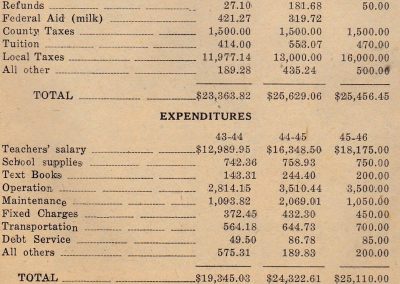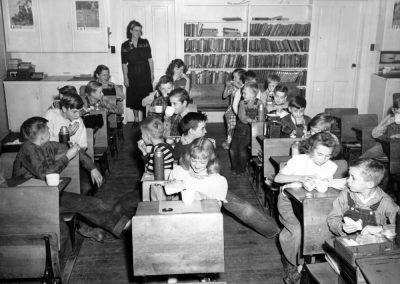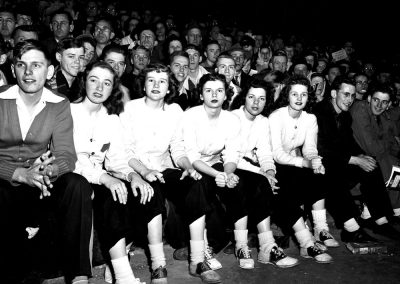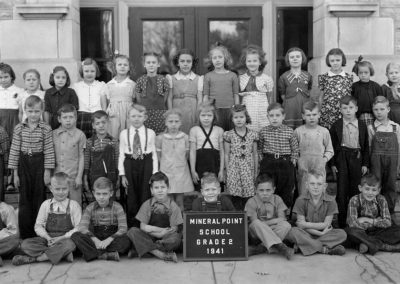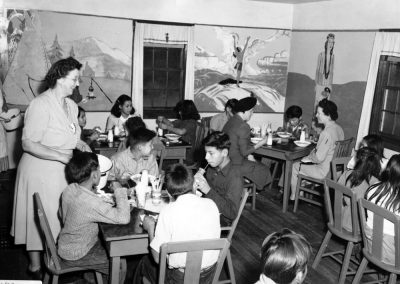Lunch at the Hochunkgra School in 1948. The murals were painted by the school’s 8th graders. The Hochunkgra School served Ho-Chunk students in the Black River Falls School District from 1934 until 1963, when the students were integrated into the district. (Photo courtesy of the Jackson County Historical Society.)
 The 1940s
The 1940s
December 7, 1941 began as a beautiful Sunday morning in Honolulu. By the next day, President Franklin D. Roosevelt was proclaiming it “a date which will live in infamy.”
The war effort affected every facet of American life. Demanding personal sacrifice, it necessitated the rationing of resources and encouraged private citizens to purchase war bonds. The atomic bombs destroying Hiroshima and Nagasaki ending World War II in 1945 ushered in the Cold War. By the decade’s end, the Soviets exploded their own A-bomb.
Other notable events of the decade: lives are saved with the mass production of penicillin, Churchill delivers his “Iron Curtain” speech, Nazis stand trial in Nuremburg, the Marshall Plan starts to help Europe recover, Mao creates the People’s Republic of China, the Taft-Hartley Act restricts labor unions, and the GI Bill of Rights helps veterans attend college and buy a home.
The WASB
- 1940: The State Education Convention registration increases to $1.50, which includes a banquet ticket.
- 1941: The directors authorize $500 to publish weekly legislative updates for all school board members.
- 1942: Delegates request that male teachers be placed in a deferred classification for Selective Service purposes.
- 1944: The association spends $35 for 1,500 copies of the first issue of the Wisconsin School Board News.
- 1945: The War Mobilization Director prohibits conferences, conventions and meetings of more than 50 people, canceling the annual convention.
- 1945: Prospective teachers drop from 2,172 in 1943 to 982 by June of 1945, creating a teacher supply crisis.
- 1946: Wisconsin public school enrollment climbs to 484,356 for the 1945-46 school year.
- 1947: Delegates debate school improvement versus tax relief, audio-visual educational aids and establishing a state board of education; the Legislature authorizes $6.5 million for school aids.
- 1949: The WASB finishes the decade with 241 member districts.
WASB Presidents
1940 – Samual Meyers – Racine
1941 – Samual Meyers – Racine
1942 – John T. Kendrigan – Ashland
1943 – John T. Kendrigan – Ashland
1944 – N.E. Masterson – Stevens Point
1945 – N.E. Masterson – Stevens Point
1946 – Hugh E. Staffon – Sheboygan
1947 – Hugh E. Staffon – Sheboygan
1948 – M.N. Hein – Chippewa Falls
1949 – John Berg – Superior
Our State
- 1941: The University of Wisconsin defeats Washington State 39-34 for its only NCAA basketball championship.
- 1943: The Nazis execute Milwaukee native Mildred Fish Harnack, graduate of Milwaukee High School of the Arts and UW-Madison, for providing intelligence to the Allies while an instructor at the University of Berlin.
- 1946: Wisconsin’s Progressive Party dissolves with members joining the Republican Party.
- 1946: Trees for Tomorrow camp becomes permanent, offering summer programs for teachers and others while expanding its effort to reforest northern Wisconsin.
- 1947: Wisconsin retires its $1.2 million Civil War debt.
- 1949: Milwaukee’s Joseph J. Zimmerman patents a telephone answering machine.
Our Nation
- 1940: Richard Wright’s Native Son tells the story of an impoverished black youth living in Chicago’s South Side and Dorothy Kunhardt writes and illustrates the first tactile book, Pat the Bunny.
- 1941: Children learn to spot enemy aircraft; and the USO begins entertaining the troops.
- 1942: “War time” moves clocks ahead one hour; and the War Relocation Authority creates Japanese internment camps on U.S. soil.
- 1943: The All-American Girls’ Professional Baseball League inaugural season includes the Kenosha Comets and Racine Belles; Victory Gardens provide fresh vegetables; and shoe rationing limits an individual to three pairs annually.
- 1944: Norman Rockwell paints Rosie the Riveter; and Roosevelt wins a fourth term.
- 1945: Harry Truman becomes president; Costello asks Abbott “Who’s on First;” and frozen dinners show up on the dinner table.
- 1946: Mothers across the country get child-rearing advice from a Dr. Benjamin Spock book and begin storing leftovers in their new Tupperware.
- 1947: Sharecropper’s son Jackie Robinson breaks major league baseball’s color barrier and becomes Rookie of the Year.
- 1948: The U.S. Supreme Court rules religious teaching in public schools unconstitutional; and the first long-playing (LP) vinyl records features the New York Philharmonic.
- 1949: The minimum wage increases from 40 to 75 cents.
